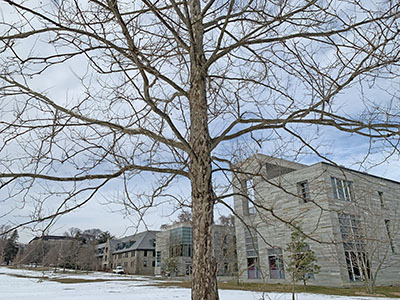
Plant of the Month: Platanus occidentalis

Few trees have such a distinguishing character as Platanus occidentalis, the American sycamore. Even to the layperson, these grand trees clearly stand out from the rest. The patchwork bark – brown, orange, green and of course, white – make these trees jump out, especially in the winter landscape. The white-tipped branches can be seen from miles away, sharply contrasting the sky and the dull tones of other trees. The bark character and imposing form of these titans make them among the most visually impressive trees anywhere.
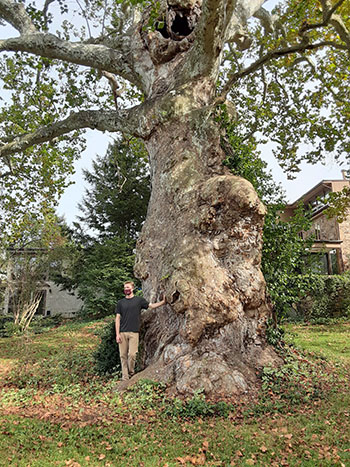
Sprawling giants can be found in farm fields, each with its own distinct character, each instantly recognizable as a sycamore. photo credit: R. Payne-Meyer
P. occidentalis boasts many representatives of the largest trees on the East Coast. The tuliptree, (Liriodendron tulipifera) may give P. occidentalis a run for its money, but P. occidentalis is generally considered the largest tree species native to eastern North America. These behemoths live over 400 years, and continue to grow until death. When open-grown, P. occidentalis trees are approximately equal in spread and height, with astoundingly girthy trunks. Sprawling giants can be found in farm fields, each with its own distinct character, each instantly recognizable as a sycamore. Trees reach 75’-100’ in height and width, growing as tall as 120’ with even greater spread potential. The Pawling Sycamore of Valley Forge, PA has an astounding average spread of 174’.
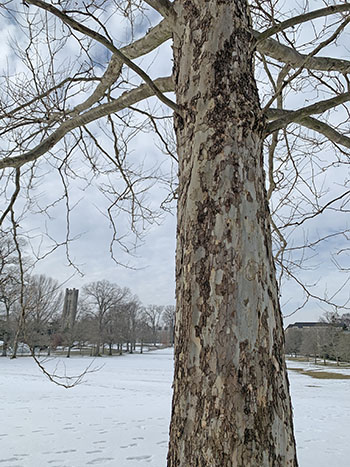
Few trees have such a distinguishing character as Platanus occidentalis, the American sycamore. photo credit: R. Robert
Many East Coast states have famous sycamore trees like the Pawling Sycamore, revered for their size and growth form. The Buttonball Tree of Massachusetts and the Pinchot Sycamore of Connecticut, are two notable sycamores of New England. The sycamores of Southeastern Pennsylvania may just take the cake though. This region is home to multiple specimens among the largest in North America, and to that end, the world.
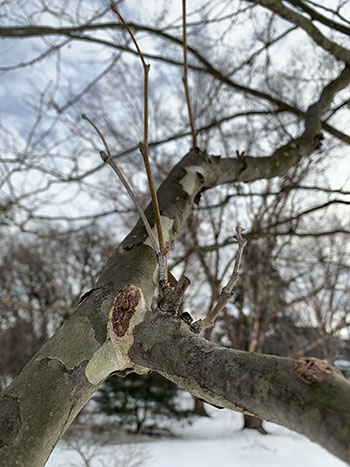
These trees, Platanus occidentalis, are an excellent choice for riparian plantings and naturalized areas, growing quickly and supporting a range of wildlife. photo credit: R. Robert
Here the author is seen in Chester County next to a P. occidentalis tree calculated at 517 points, bested (arguably) by only one other sycamore in Mercersburg, PA with 529 points. (Score = trunk circumference (in.) + tree height (ft.) + ¼ average crown spread (ft.)). Check out the website for champion trees of Pennsylvania, pabigtrees.com, to learn about these prized sycamores and other awe-inspiring specimens across the state.
P. occidentalis trees are impressively adaptable, growing from Southern Canada to Florida, westward to Texas. This species wants full sun, and while found almost exclusively in wetland and riparian areas, prefers a well-drained soil. Despite the specificity of naturally occurring plants, P. occidentalis is easily grown in garden and lawn settings. A wide tolerance of pollutants makes P. occidentalis is a great fit for the city or countryside. The actual fit of this tree in the landscape proves more challenging.
In a residential setting this tree can be more a burden than a blessing, with exfoliating bark, fallen twigs and fruit creating a mess. This, plus an aggressive root system, makes P. occidentalis poorly suited as a street tree. This noble tree is right at home in a park setting though. Here a little messiness can be overlooked and trees may provide shade and wildlife refuge for hundreds of years. P. occidentalis trees are as impressive grown en masse as singly; the collective effect of a sycamore grove is stunning. These trees are an excellent choice for riparian plantings and naturalized areas, growing quickly and supporting a range of wildlife.
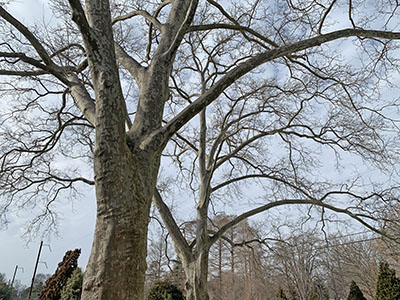
A hybrid species between P. occidentalis and P. orientalis, P. x acerifolia is commonly found across the U.S. and Europe due to extreme adaptability and urban tolerance. photo credit: R. Robert
A hybrid species between P. occidentalis and P. orientalis, P. x acerifolia is commonly found across the U.S. and Europe due to extreme adaptability and urban tolerance. With similar bark and stature to P. occidentalis, it can be hard to tell these two trees apart. This lookalike cousin can be most easily distinguished from P. occidentalis by the fruit: P. x acerifolia fruit usually comes in pairs of two, while P. occidentalis fruits occur singly.
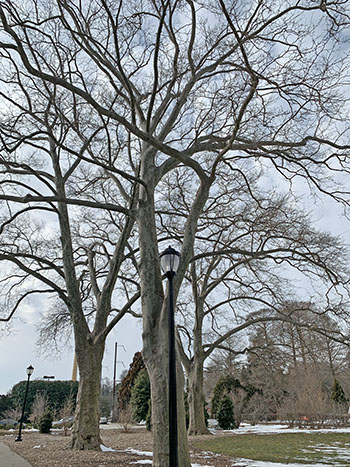
With similar bark and stature to P. occidentalis, it can be hard to tell P. x acerifolia from P. occidentalis. photo credit: R. Robert
Unfortunately, P. occidentalis is susceptible to plane anthracnose from the fungal pathogen Apiognomonia veneta. This introduced fungus found its original host in P. orientalis, though this species and, to a lesser extent, P. x acerifolia, exhibit resistance to it. P. occidentalis trees are often heavily affected by this foliar disease. Though plane anthracnose does not cause serious harm to P. occidentalis, it does cause unsightly defoliation which reduces the ornamental value and growth potential of the tree. The disease overwinters in diseased leaves and cankers on branches. Removal of leaves and branches from the ground nearby helps to prevent infection. Branches with cankers and any dead branches should also be pruned.
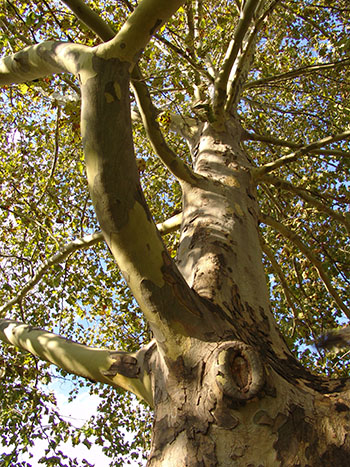
Platanus x acerifolia ‘Bloodgood’ is another cultivar to consider. photo credit: R. Robert
Bizarrely, Platanus trees are considered by some to be the closest relatives of the aquatic lotus genus, Nelumbo. Both Platanus and Nelumbo are likely living fossils, surviving species from a formerly much larger group of related plants. Like its forgotten relatives, P. occidentalis faces the threat of being phased out, at least in gardens. There are so many things I find fun and fascinating about this tree, it is my hope and prayer that this species sees a comeback in landscape use. Lest we forget the majesty of the American sycamore!





Alan Kruza
Posted at 09:28h, 18 FebruaryExcellent article, Rowan. Thanks.